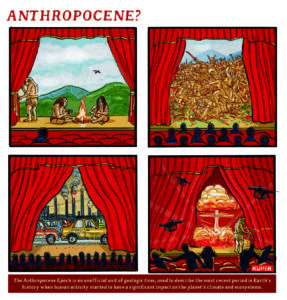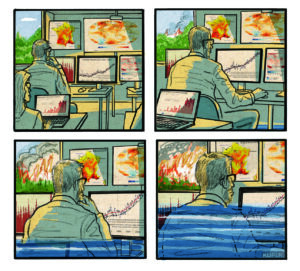Earth’s Inner Heat Melts Greenland Ice
Greenland’s icesheet is melting, at the surface and at its base, due to the normal warmth of an active rocky planet.
By Tim Radford, Climate News NetworkThis piece first appeared at Climate News Network.
LONDON — Greenland is the largest single reservoir of ice in the northern hemisphere and, with Antarctica, a big contributor to sea level rise. The island sheds 227 billion tonnes of ice every year, and this alone lifts the mean ocean levels by 0.7mm (the seas are rising by 3mm each year in total). Alexey Petrunin and Irina Rogozhina of the GFZ German Research Centre in Potsdam report in Nature Geoscience on a new approach to the great Greenland riddle: what is happening to the ice?
They coupled an ice/climate model that should simulate what happens as temperatures shift, and linked it to a thermo-mechanical model of the planet’s crust and upper mantle far below the island.
Geophysicists call this region the lithosphere: temperatures below the surface increase steadily with depth, and it is the heat from the mantle that powers sea-floor spreading and sends continents drifting across the globe on tectonic plates. Heat from the lithosphere is also the driver, around the world, for boiling mud pools, hot springs, geysers, volcanic discharges and unexpectedly wet, slippery rocks at the base of glaciers.
But there is a catch for scientists who try to model the processes in the lithosphere, especially in heavily glaciated regions. The colossal weight of ice presses down on the rocky crust, and deforms it. The mountains of Scandinavia, once covered by thick glaciers during the ice age, are still rebounding as the depressed lithosphere springs back into shape. What the Potsdam scientists had to do was adjust the model to square with temperature differences observed at separate boreholes and variations in seismic and magnetic data.
Thin rocks and thick ice
At the bottom, Greenland’s subglacial rocks can be warm in one place, cold in another – and very thin, for a 2 billion year old slab of crust, “anomalously thin” say the Potsdam team. This lithosphere heat would be of no great consequence if Greenland were exposed rock, but because it bears a permanently insulating sheet of thick ice, the heat flow from deep in the Earth becomes an important part of the pattern of change.
They ran their model to cover a simulated three million-year span, and settled the argument: the dynamics of the Greenland ice sheet are affected by the heat flow from the planet’s interior. “Our model calculations are in good agreement with the measurements,” said Dr Petrunin. “Both the thickness of the ice sheet as well as the temperature at its base are depicted very accurately.”
Now researchers know a bit more about the dynamics of the ice sheet, they can start to calculate the rate of melting in the decades ahead, and in the Proceedings of the National Academy of Sciences, a large group of international scientists, led by Sarah Shannon of the University of Bristol in the United Kingdom, has been trying to make sense of the flow of surface and subterranean meltwater from the Greenland ice sheet.
The concern is that the melting at the base could lubricate the movement of the glaciers and possibly accelerate the loss of ice as great blocks of the stuff hit the coast and calve as icebergs. They conclude that it could, but there’s no evidence to say that it is doing so right now. For the moment, on the evidence of simulations based on climate models, and on observations so far, they calculate that Greenland’s contribution to sea level rise from basal melting will be small: no more than 5%.
Your support matters…Independent journalism is under threat and overshadowed by heavily funded mainstream media.
You can help level the playing field. Become a member.
Your tax-deductible contribution keeps us digging beneath the headlines to give you thought-provoking, investigative reporting and analysis that unearths what's really happening- without compromise.
Give today to support our courageous, independent journalists.









You need to be a supporter to comment.
There are currently no responses to this article.
Be the first to respond.